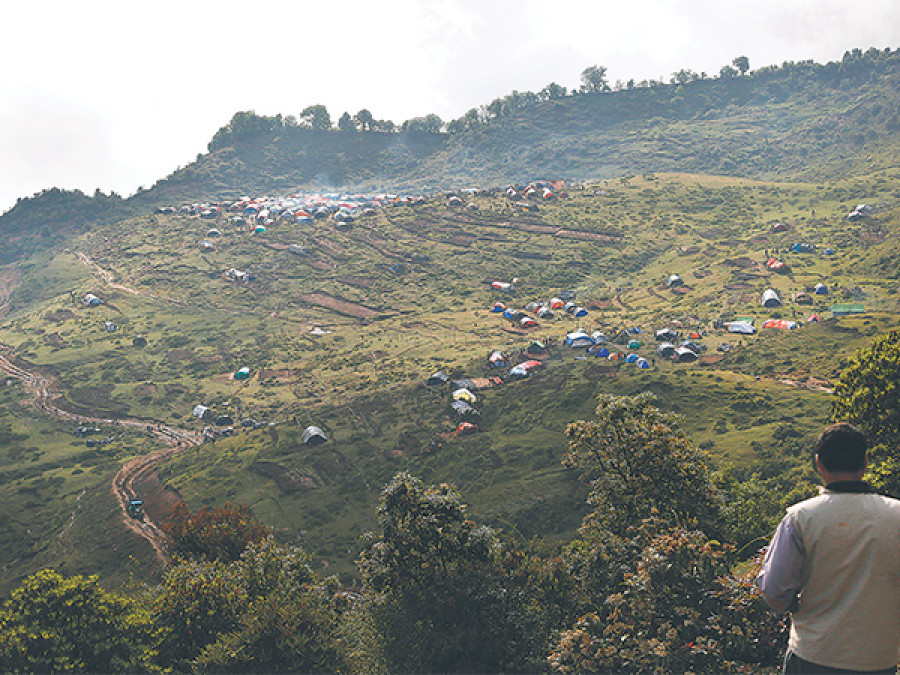Miscellaneous
Shelters to houses
The Wednesday before last, on the day of the Teej festival, a colleague and I met with a group of volunteers in Gorkha Bazaar to understand why the reports they had been sending sounded repetitive week after week.
Weena Pun
The Wednesday before last, on the day of the Teej festival, a colleague and I met with a group of volunteers in Gorkha Bazaar to understand why the reports they had been sending sounded repetitive week after week. These volunteers, five in each of the 14-most quake-affected districts, travel to villages and gather information on relief work, what the affected families need, whether they are getting it and, if they are, who is providing it for them. Lately, one of the answers to what the families need has been overwhelmingly ‘permanent shelter’.
It does sound obvious. More than 602,000 houses were completely destroyed in the April 25 earthquake, which roughly translates to the same number of households, if not more, rendered homeless. In the immediate aftermath, temporary shelters made of corrugated galvanised iron sheets and tarpaulins were good enough. Monsoon was around the corner and even if the families had the means, they could not have built houses in that season. Furthermore, there were abundant promises from the government that when the reconstruction phase would begin, it would be generous with monetary aid and loans. In the meantime, the families busied themselves with harvesting corn and planting rice and millet.
But, now, the monsoon is over; so is work on the fields for the moment. And it has been almost five months since the earthquake. The only government help the families have directly received is Rs 15,000 for each household whose house was completely destroyed in the earthquake. That money has already been spent on galvanised iron sheets or on food supplies. The volunteers reiterated that they were not being lazy with report writing or that there was a lack of issues, but that the dominant concern indeed has to do with permanent shelter.
“Temporary shelters are by definition temporary. People are now anxious to move on and have a place they can call home. Once they have a house, other things will fall into place. But they are all confused about how this dream can be realised,” says Raj Gurung, a volunteer who covers Laprak and Barpak, the epicentre of the Great Quake.
The primary source of the confusion is the slow progress on the formation of the National Reconstruction Authority, which when formed would be the supreme body that would overlook the resettlement and rehabilitation of the affected families. The Reconstruction Authority had indeed been formed before the donor’s conference on June 25, when donors pledged more than USD 4 billion in grants and loans. Subsequently in mid-August, Govinda Raj Pokharel, the vice chair at National Planning Commission, was appointed as the Chief Executive Officer of the Authority.
But the Authority had been formed through an ordinance, which unless endorsed by Parliament, had no validity. The ordinance expired at the end of August before it ever went to Parliament. The government then tabled a bill at Parliament in mid-September, but it is yet to be passed and enacted.
This dilly dallying in passing the bill, whether for political reasons or otherwise, has had direct impacts on families wishing to rebuild their houses, in two major ways. One, the families are not yet able to receive Rs 200,000 each, which the government had promised in aid to every affected household. This money could be the capital required to restart the building process. The Ministry of Urban Development, which it says is the agency to distribute the amount, says the budget has been allocated, but a working procedure has yet to be approved by the Cabinet.
Second, the families are not able to apply for bank loans at a 2 percent interest rate. The government has promised such loans (amounting up to Rs 2.5 million inside the Valley and up to Rs 1.5 million outside the Valley) to affected families. The Nepal Rashtra Bank has already issued a directive instructing all commercial banks and financial institutions to start the process for disbursing loans. But most commercial banks have not yet formulated guidelines to process loans, mostly because what an applicant needs to submit together with the application is a VDC/municipality-approved blueprint of their house.
Until now, people in villages could build mud-and-stone houses without having to get their designs approved by the government. Now, with the release of the Basic Guidelines on Settlement Development, Urban Planning Building Construction-2015, prepared by the Ministry of Federal Affairs and Local Development, a house in a VDC with more than 1,000 houses—almost all in the earthquake-affected districts—has to be approved by the VDC first. VDCs were to convene their respective village council meetings, endorse building codes and set up a procedure to approve blueprints eight days ago. They missed the deadline and one of the reasons is the delay in finalising earthquake-resistant house designs by the Ministry of Urban Development.
“The lack of formation of the Reconstruction Authority cannot be used as an excuse by government agencies to not do the work assigned to them. But until the Authority gains a legal status, their work will remain incomplete,” said Swarnim Wagle, a member of the National Planning Commission.
Because almost all work related to reconstruction is pending, affected families have started to find the government’s promises of aid akin to the political parties’ empty promises during elections. The formation of the Reconstruction Authority could remedy this, by pushing work in every department ahead.
Now that the constitution has been promulgated, the government and the political parties should work on the Authority right away. As demonstrated by a line from a song some women were singing that Wednesday in Gorkha Bazaar—balla balla rahatle aasu puchhiyo—relief and reconstruction work has a power to help people forget the tragedy the earthquake wrought.




 10.12°C Kathmandu
10.12°C Kathmandu










